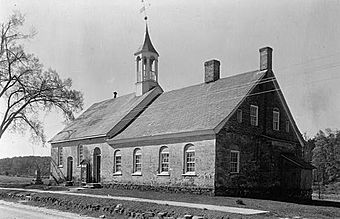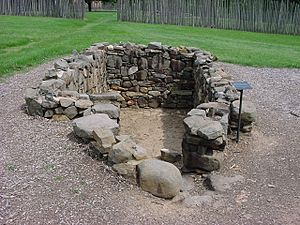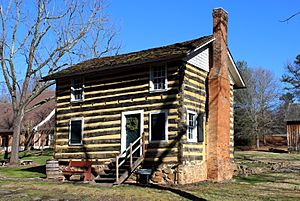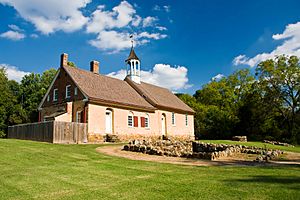Bethabara Historic District facts for kids
|
Bethabara Historic District
|
|

Bethabara Moravian Church in 1934
|
|
| Location | North of Winston-Salem on NC 67, near Winston-Salem, North Carolina |
|---|---|
| Area | 41 acres (17 ha) |
| Built | 1753 |
| NRHP reference No. | 78001948 |
Quick facts for kids Significant dates |
|
| Added to NRHP | November 15, 1978 |
| Designated NHLD | January 20, 1999 |
The Bethabara Historic District is a special place in North Carolina. It protects the old buildings and hidden remains of a small Moravian village. This village was first settled way back in 1753.
Today, Bethabara is a public park in Winston-Salem. It was recognized as a National Historic Landmark in 1999. This means it's a very important historical site for the whole country.
Contents
Bethabara's Early History
Bethabara means "House of Passage" in Hebrew. It was the name given to a village in what is now Forsyth County. In 1753, twelve men from the Moravian Church started this settlement.
They built their first homes in an abandoned cabin. This land was part of a huge 100,000-acre area. The Moravians bought it from Lord Granville and called it Wachovia.
Life in the First Settlement
The early settlers of Bethabara were very skilled farmers. They had an amazing medicine garden. This garden grew over fifty different kinds of herbs. These herbs were used for healing and other purposes.
Bethabara was not meant to be a forever home. The Moravians planned to stay there until they found a better spot for a main town. But things changed quickly.
Challenges and Growth
Just six months after they arrived, the Seven Years' War began. In America, this war was known as the French and Indian War. The fighting spread to North Carolina.
Bethabara became a safe place for many people fleeing the war. These "refugees" stayed there until 1761. Because of the war and the growing number of people, building a main town was delayed for thirteen years.
Moving to Salem
By 1766, it was finally safe to start building the main town. This new town was called Salem. Many buildings in Bethabara were carefully taken apart. Their materials were then used to build new structures in Salem.
As houses were removed, their small underground storage areas, called root cellars, were filled in. In 1771, Salem was finished. It became the official center of the Moravian community.
Most residents moved to Salem. Bethabara then became a farming community. It grew food to supply the other Moravian towns in Wachovia.
Later Years of Bethabara
In 1788, an enslaved person named Johann Samuel became the farm's manager. He was freed in 1801 after serving the Moravians for 50 years. Bethabara slowly became less important.
Farming and making pottery were the main jobs there. This continued well into the 1850s.
Historic Bethabara Park Today
Today, you can visit what's left of the old village. This area is called Historic Bethabara Park. You can see the foundations of the original buildings.
The Bethabara Moravian Church, also known as the Gemeinhaus, has been restored. There's also a rebuilt palisade (a fence of strong posts) and colonial gardens. A famous archaeologist named Stanley South dug up the site in the 1960s.
Exploring the Park
The park covers 183 acres and is also a wildlife preserve. It's in Winston-Salem and run by the city's Recreation & Parks Department. It's like an open-air museum where you can see history come alive.
The park also has 20 miles of nature trails for you to explore. Many festivals and reenactments happen here. For example, there's an Independence Weekend Celebration around July 4th.
The Bethabara site was named a National Historic Landmark in 1999. The Gemeinhaus church was separately added to the National Register of Historic Places in 1971.
See also






